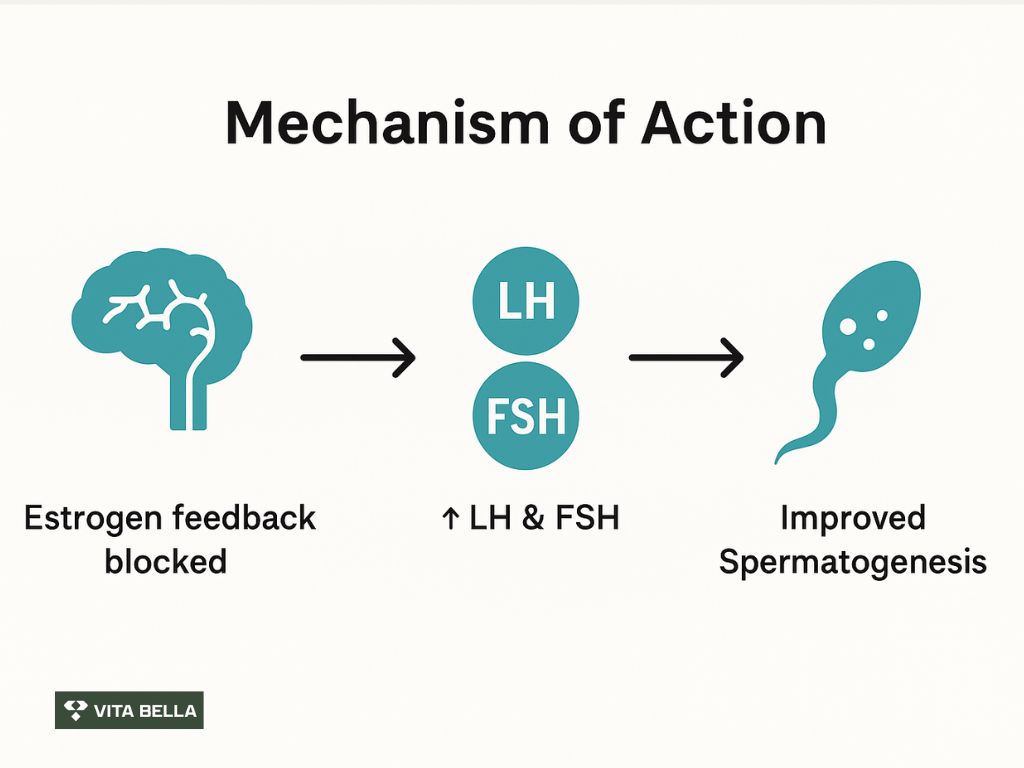Infertility affects many couples worldwide, and male factors contribute to nearly half of those cases. Among medical options, clomiphene citrate (a selective estrogen receptor modulator, or SERM) is increasingly used off-label to boost male fertility. In this article, you’ll learn how clomiphene works in men, the benefits it offers, and what side effects to watch for.
Male infertility can feel like an overwhelming challenge, but science is opening new doors. At Vita Bella, we believe in turning struggles into solutions with evidence-based treatments. Clomiphene citrate is proving to be a safe, effective, and affordable therapy that restores hormonal balance and may improve sperm health. Ready to discover how this simple oral medication can make a real difference in your fertility journey? Keep reading to learn more.
How Clomiphene Works in Men?
Clomiphene 1 acts by blocking estrogen’s negative feedback at the hypothalamus and pituitary, which in turn stimulates increased release of luteinizing hormone (LH) and follicle-stimulating hormone (FSH). That hormonal shift encourages the testes to increase endogenous testosterone production and support spermatogenesis.
Clinically 2, this mechanism helps men with functional hypogonadism or idiopathic infertility maintain or improve testosterone levels without suppressing sperm production, a key advantage over exogenous testosterone.
A recent prospective randomized, placebo-controlled trial 3 in infertile men with idiopathic oligoasthenozoospermia confirmed that 50 mg daily clomiphene for 3 months significantly increased sperm concentration and motility compared to placebo, and also improved testosterone levels.
Another human study 4 in idiopathic, nonobstructive male infertility reported that among 52 men treated with clomiphene, over 50% achieved improvements in sperm parameters, and some achieved pregnancies. Meta-analyses 5 support these benefits: one review found that clomiphene therapy produces statistically significant increases in sperm concentration and motility with minimal side effects reported.

What are the Key Benefits and Advantages?
Clomiphene citrate naturally enhances testosterone levels and improves sperm concentration, motility, and semen volume, without compromising fertility. As an affordable, oral treatment, it offers men a safe and effective first-line option to enhance reproductive potential.
Improves sperm concentration & motility: Meta-analyses 5 show consistent gains in sperm count and movement over baseline.
Boosts endogenous testosterone: In men with low testosterone, clomiphene raises levels meaningfully while preserving fertility.
Non-suppressive of spermatogenesis: Unlike testosterone replacement therapy, clomiphene maintains FSH and LH, ensuring intratesticular testosterone production continues.
Good safety & tolerability: Large retrospective cohorts report 6 low rates of serious adverse events in male users, and even modest declines in gynecomastia, skin disorders, and hypertension in some cases.
Sustained effectiveness: Long-term use of clomiphene appears to maintain eugonadal testosterone levels with continued symptom improvement.
What Side Effects to Expect?
While clomiphene is generally well-tolerated, some side effects have emerged in human trials. These tend to be mild, reversible, and relatively uncommon.
Visual disturbances: About 1.5% of treated men report transient blurred vision, light sensitivity, or diplopia these almost always resolve after stopping therapy.
Gastrointestinal upset: A small number of patients experience nausea, abdominal discomfort, or dizziness.
Acne or skin changes: Occasional reports 7 of acne flare or mild skin changes appear in retrospective reviews.
Gynecomastia: Rarely, lean men may develop mild breast tenderness or glandular tissue; however, some cohort data 6 even show a decrease in gynecomastia incidence post-therapy.
Liver enzyme changes: A few cases of transient hepatic enzyme elevation have been documented; for instance, one trial 7 reported one patient out of a small cohort with elevated enzymes.
In long-term safety studies 5, no severe or life-threatening adverse events emerged, and clomiphene maintained a favorable risk profile across years of use.
What are the best Practices and Monitoring Suggestions?
Clomiphene citrate works best when started at low doses with regular monitoring of testosterone, LH, FSH, and semen parameters every few months.. To maximise benefit and minimise risk, many clinicians follow these practices:
Begin with lower doses (e.g. 25–50 mg daily or every other day), and adjust based on hormonal and semen response.
Monitor serum testosterone, LH, FSH, and estradiol, plus semen parameters (concentration, motility) at baseline and at 3 to 6-month intervals.
Watch out for visual symptoms or GI disturbances; any new visual issue merits prompt discontinuation.
Consider limiting duration to 6–12 months initially; evaluate benefit vs side effects.
Use in men with intact hypothalamic-pituitary-gonadal axis rather than primary testicular failure, since response is more predictable.
Interpretation of Key Numbers and Outcomes
In the large retrospective male-usage study 6, side effect rates remained very low and no increased risk of thrombotic events, vision problems, or liver disease was found.
The RCT in idiopathic oligoasthenozoospermia reported 3 that a significantly higher proportion of treated men upgraded WHO sperm concentration categories vs placebo (exact percentages not quoted in abstract) and minimal side effects, including 1.5% risk of visual disturbances.
In the retrospective cohort 4 of 52 infertile men, over 50% achieved improvements in sperm parameters; some also achieved pregnancy.
From Silent Struggles to New Possibilities
Male infertility is rarely talked about, yet it affects millions worldwide. Poor sperm quality can leave couples feeling helpless. At Vita Bella, we’re changing that narrative. With safe, effective therapies like clomiphene citrate, men can reclaim control, boost fertility, and take meaningful steps toward building the family they dream of.
FAQs
How long does it take for clomiphene citrate to improve sperm quality?
Testosterone levels may rise within the first few months, but noticeable improvements in sperm count and motility often take about 6–9 months of consistent treatment. Patience is essential, as sperm development cycles naturally take time, and long-term use often shows the most benefits. Regular checkups help track progress effectively.
Is clomiphene citrate safe for men?
Yes, most men tolerate it well, with very few experiencing side effects. It is considered a safe and effective first-line option for male infertility when prescribed under medical supervision. Doctors often prefer it over testosterone replacement since it preserves fertility, making it a reliable choice for men hoping to conceive.
Can clomiphene citrate actually help achieve pregnancy?
Yes, in many cases improved sperm quality from clomiphene therapy has translated into successful pregnancies. However, outcomes depend on multiple factors, including overall health and partner fertility. It is often used as a first step before moving to more advanced fertility treatments, offering couples a less invasive path toward conception.
What side effects should men be aware of?
Clomiphene is generally well tolerated. Mild side effects may include visual changes, stomach upset, or skin changes, and these usually resolve once treatment is stopped. Most men report few or no issues, and regular monitoring ensures any potential problems are detected and managed early.
References:
Wu, Y.-C., & Sung, W.-W. (2024). Clomiphene citrate treatment as an alternative therapeutic approach for male hypogonadism: Mechanisms and clinical implications. Pharmaceuticals, 17(9), 1233. https://doi.org/10.3390/ph17091233
Herzog, B. J., Nguyen, H. M. T., Soubra, A., & Hellstrom, W. J. G. (2020). Clomiphene citrate for male hypogonadism and infertility: An updated review. Androgens: Clinical Research and Therapeutics, 1(1), 62-69. https://doi.org/10.1089/andro.2020.0005
Shukla, J., Moni, S. N., Hasan, M. M., Islam, M. A., Shikha, A. N., Jahan, N.-W.-B., & Ishrat, S. (2025). Clomiphene citrate improves sperm parameters in infertile men with idiopathic oligoasthenozoospermia. Clinical and Experimental Reproductive Medicine, 52(3), 252–258. https://doi.org/10.5653/cerm.2024.07353
Huijben, M. M., Lock, M. T. W. T., De Kemp, V. F., De Kort, L. M. O., & van Breda, J. H. M. K. (2023). Clomiphene Citrate a first step to improve idiopathic male infertility: A retrospective analysis. Andrologia, 2023, Article 8743882. https://doi.org/10.1155/2023/8743882
Huijben, M., Huijsmans, R. L. N., Lock, M. T. W. T., de Kemp, V. F., de Kort, L. M. O., & van Breda, J. H. M. K. (2023). Clomiphene citrate for male infertility: A systematic review and meta-analysis. Andrology, 11(6), 987–996. https://doi.org/10.1111/andr.13388
Guo, D. P., Zlatev, D. V., Li, S., Baker, L. C., & Eisenberg, M. L. (2020). Demographics, usage patterns, and safety of male users of clomiphene in the United States. World Journal of Men’s Health, 38(2), 220–225. https://doi.org/10.5534/wjmh.190028
Okada, K., Sato, K., Ohnishi, A., Kaku, Y., Ishida, T., Chiba, K., & Fujisawa, M. (2022, May). 213 Effect of Clomiphene Citrate Therapy for Male Infertility. The Journal of Sexual Medicine, 19(Supplement_2), S207. https://doi.org/10.1016/j.jsxm.2022.03.471





















